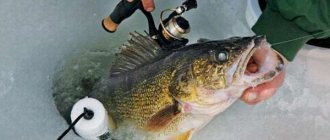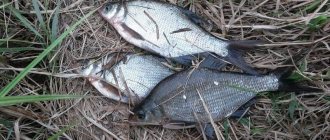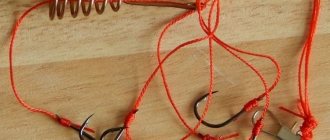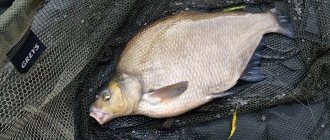Does crucian carp bite on foam plastic?
Polystyrene foam is one of the most commonly found artificial materials. It is actively used in many industries, thanks to a whole range of useful characteristics and properties. This material is often used in fishing, since its bright and contrasting shade makes the balls stand out from other water bodies. At the same time, foam plastic can be stored for many years, without requiring special storage conditions, and is several times cheaper than natural baits.
Did you know? Foam balls were invented by the German company BASF in the 40s of the twentieth century. They became the basis for the production of thermal insulation material under the Styropor brand, which is still produced today.
Although not every species of fish can be successfully caught with such bait, the same cannot be said about crucian carp. This aquatic inhabitant almost always pays attention to the ball; for this you just need to skillfully use bait. At the same time, an adult and large crucian carp by itself rarely pays attention to the ball, especially if there is enough natural food in the reservoir.
Despite this, it is still possible to catch crucian carp using polystyrene foam, but only in conjunction with a macaque. When fishing this way, you can skillfully disguise any hooks with white and multi-colored balls. In this case, the fish swallows the ball along with the complementary food as small debris suspended in the water column and hooks itself when filtering the liquid through the gills.
Advantages of polystyrene foam as bait
Many fishermen do not believe that it is possible to catch anything using polystyrene foam, let alone large catches. And all because they do not know the principle of its operation. They also do not know about the advantages that this artificial attachment has. Let's list the main ones:
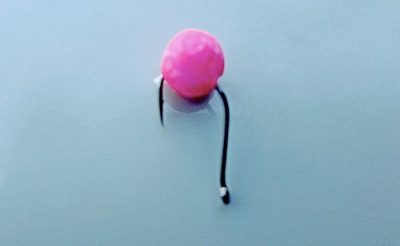
The material has a high degree of buoyancy, thanks to which it is always in the water column, regardless of the current speed.- In their appearance, the balls resemble particles of food familiar to white fish (meaning tinted foam).
- They stay securely on the hook and remain in place even after a sharp cast.
- Polystyrene foam retains odor well, including in water. If you rub it with a fragrant substance, the aroma will last for quite a long time.
- The balls go well with animal and plant baits.
- Their cost is very small, one small bag costs a penny.
- The durability of the material allows you to stock up on it for at least a year in advance.
When is the best time to catch
The most optimal period for catching crucian carp using polystyrene foam lasts throughout the spring and until mid-June. At this time, at temperatures from +5°C to +20°C, the fish most actively pays attention to the balls and begins to bite with minimal feeding. And there are completely rational and understandable reasons for this. First of all, during this period the most active warming is observed, which gives fish the opportunity to leave the deep wintering grounds. In turn, a sharp activation of the body requires additional energy consumption, so the crucian carp tries to get enough of any food. Additionally, the success of the foam is supported by a meager food supply, which is restored after winter only at the beginning of summer.
We advise you to find out how crucian carp differs from carp and other fish.
Tackle for fishing for crucian carp
Often, when fishing with foam balls, most fishermen pay insufficient attention to the selection of appropriate equipment. There is an opinion that almost any gear used in modern fishing is suitable for this. However, in fact, in order to catch crucian carp with artificial bait to be successful, you need to choose the right line and rod, as well as the reel.
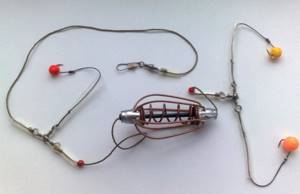
Selection of equipment
As practice shows, polystyrene foam has good buoyancy and also has low water absorption capacity. That is why, in the case of its use, float gear is simply excluded. Such bait will float to the surface almost immediately and often the additional amount of weights does not completely solve all the problems associated with this.
Did you know? The most expensive crucian carp in the world was sold in 2021 in Japan. A local resident paid $1.8 million for an ornamental nine-year-old koi fish, which is an absolute record.
In this case, the only solution is to use gear for so-called bottom fishing (feeder, donk, etc.). The basis of the submersible structure should be a feeder, with hooks installed on leashes. In this case, foam is used to mask the hook and focus special attention on it. For this purpose, the equipment is loaded with so-called carp hooks with a concave point, measuring from 6 to 10 mm. In this case, it is recommended to fasten the mounted hooks on short leashes. Their length should be no more than 2–5 cm, due to which the foam will intensively “play” around the feeder, which arouses the interest of the fish.
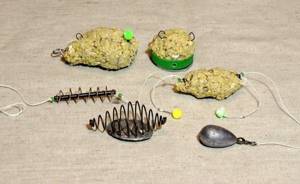
Rod
A fishing rod for such fishing should be of medium length, made of durable carbon fiber. Often, to do this, it is enough to take a spinning rod or a feeder rod 2.7–3 m long. If a bell or other signaling device is used during fishing, the softness of the finishing knee of the rod does not matter. In all other cases, the softest tip should be installed at the top, which will respond to the slightest bite.
It will be useful for you to know at what atmospheric pressure crucian carp bites best.
Coil
To ensure optimal fishing, the reel should be installed as a spinning reel. There are no requirements for its other design features. However, it is recommended to focus on models that can accommodate at least 50 m of fishing line with a thickness of about 0.3 mm. In this case, a spool size in the range of 2500–3000 will often be quite sufficient.
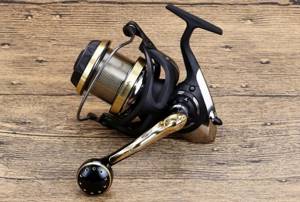
fishing line
In most cases, a thin but strong fishing line with a diameter of about 0.2 mm is used to catch crucian carp. Moreover, due to the fact that weighted tackle is used for such fishing, it is recommended to install a fishing line with a safety margin on the rod. For this, you can use absolutely any model with a thickness of 0.25–0.3 mm. The leash on the feeder is made of thinner fishing line, 0.15–0.2 mm in diameter, in this case, if it becomes entangled in a water obstacle, the loss of all the gear can be avoided.
Important! The fishing line must be braided; only in this case can high strength be achieved with minimal thickness.
Gear installation process
Fishermen know a huge number of different ways to effectively install equipment. Thanks to this, you can choose the best option for almost any fishing conditions. However, there are several basic methods that can almost completely satisfy all the requirements of fishermen. Most often, a feeder is attached to the main line, and then 3 leashes with hooks are mounted down from it using swivels. In this case, the length of the entire structure should not exceed 2-3 cm. After this, polystyrene foam is placed on each hook.
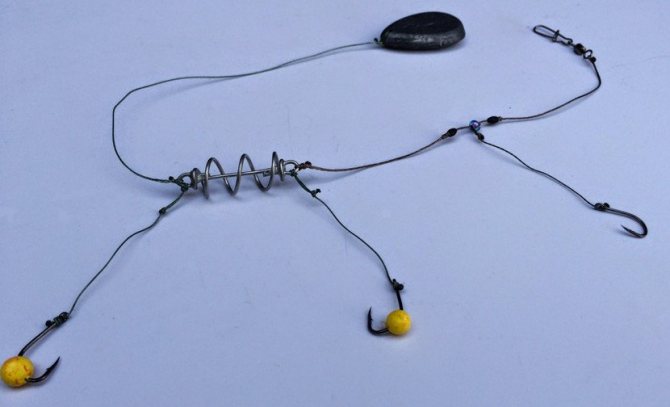
This design allows you to achieve a natural “game” of the bait at a minimum distance from the feeder. And this greatly increases the fishing efficiency.
The so-called feeder equipment is also successful.
Pay attention to the information on how to prepare wheat for crucian carp fishing.
For this:
- Take a piece of main line 30–40 cm long, and then fix the hook on one edge.
- Step back 5–8 cm from the hook, and then install the feeder using stop beads.
- Tie a 5 cm long leash on the back (free) side of the feeder.
- Place foam on the hooks, then attach the structure to the main fishing line.

What type of foam should it be?
Foam balls for catching bream can either be purchased at a fishing store or made independently by simply crumbling a piece of building material and painting it in different colors.
It is not known why prey reacts better to colored material, choosing, as a rule, light balls. There is an opinion that white foam reminds fish of plant seeds, and yellow one looks like boiled corn, but this is just an assumption. There is another version. Allegedly, the fish perceive the foam as garbage and try to discard it from the bait, getting hooked.
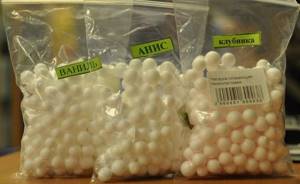
Like its river brothers, bream is very sensitive to all kinds of aromas. As bait, you can use polystyrene foam rubbed with vanilla or garlic. In order for the material to retain its scent for as long as possible, experts recommend immersing it in an aromatic solution for 5–10 hours. In a small pond, foam treated in this way can attract bream from literally all over the pond.
Here you can read how to bake bream in the oven.
How to place foam on a hook
Not every fisherman manages to correctly attach the foam to the hook, and the intensity of the bite often depends on this. The bait should be secured so that the hook is completely hidden from the fish, and the tip should instantly hook it even at the slightest touch. That is why when preparing equipment you should adhere to the principle of harmony, using from 1 to 3 balls. To do this, you should definitely pre-train a few days before going out onto the pond.
Find out also how to prepare pearl barley for fishing in a thermos.
Also, when setting balls, the buoyancy of the tackle must be taken into account. When diving, the equipped hook should stay well in the water column. If the tackle lies on the bottom, or vice versa, pulls the feeder up, you need to adjust its buoyancy. Ideally, this should be done in a separate container, before the main casting of the bait.
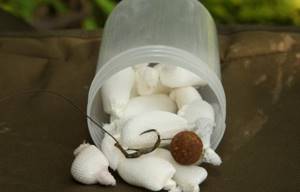
Do sizes matter when fishing with foam?
When talking about polystyrene foam, some fishermen insist on using thin (light) hooks so that the ball lifts them above the bottom, they say, this is especially important on lakes where there is no current, which on rivers helps to play along with bait. I don’t see any fundamentally important nuances at this point. Yes, I try to use thinner hooks, but when I run out of them, I start using everything that is left, and, to be honest, I didn’t feel any obvious difference in the results. If the fish is already standing still, digging in the bottom silt next to the bait, then it doesn’t matter to it whether a thin hook that floats up or a thick hook that lies almost motionless on the bottom, it bites equally.
But everything is foam plastic, which is larger than 5mm and significantly reduces the number of bites . But I’ll also make a reservation: this point is significant only in small reservoirs. On deep lakes the story is different. If a white bream from 300 g is suitable, it will eat everything you offer. Moreover, large polystyrene balls can sort large fish from small and medium ones, and if I have to go to natural lakes, I take polystyrene foam of different sizes. Usually the most popular option is 4-5 mm balls.
The best bait
To catch crucian carp with artificial bait, you can use absolutely any plant bait. Most often, oatmeal, corn, millet and wheat porridge, as well as all sorts of their combinations, are used for this. At the same time, you can also use a variety of purchased options from a nearby fishing store.
Important! Bait should be taken in reserve - in order for crucian carp to be caught well on foam plastic, it must be thrown constantly and in large portions.
The main requirement for bait is the ability to create a dense cloudy cloud around the feeder and bait . This makes it possible to more effectively hide the artificial origin of the gear, as well as writhing leashes. To do this, both store-bought bait and homemade bait must be mixed with crushed shortbread in a 4:1 ratio.

Porridge for feeding and catching bream on polystyrene foam
For summer bream fishing using this method, I use only one type of porridge to stuff into the feeder. Bream respects it very much and it is suitable for this type of fishing.
The recipe for this porridge is simple, both in composition and in cooking time.
The composition of the bait in the spring is given approximately, in mass parts:
- millet-2 parts
- semolina-3 parts
Cook the millet in a wide, large saucepan until half cooked and almost all the water has boiled away. The cereal should only swell and not begin to boil. As soon as the water has boiled, add dry semolina to the pan in parts, starting to stir.
The porridge thickens; you need to stir and add semolina until all the water has disappeared and dry grains of semolina begin to remain. After this, you need to crush the porridge firmly and cover the pan overnight to allow the semolina and millet to swell.
In the morning, the bait for catching bream on polystyrene foam will be ready. If some dry grains of semolina come across, then this is not scary, and even better for biting bream. Sometimes I prepare porridge for catching bream so that the dry semolina in the prepared bait is about one third of the total semolina poured into the pan.
Fishing technique and tactics
The tactics and technique of catching crucian carp with foam balls are practically no different from fishing techniques using other baits. At the same time, special attention is paid to the feeder and bait, since it is they that attract the attention of the crucian carp. For successful fishing, spring feeders are used, only they have all the properties necessary for fishing. In lakes and rivers with small currents, open spring structures are used; for reservoirs with intense currents, models with the maximum number of turns are suitable.
Read the description and characteristics of silver crucian carp.
Regarding complementary feeding, in reservoirs with minimal current it should be loose or semi-viscous. In turn, with a strong current, a viscous consistency is considered optimal. This little trick will allow you to achieve an optimal regime for washing out complementary foods, and as a result, maximum efficiency of the equipment. It is also recommended to pay attention to the length of the leash. For standing reservoirs it should correspond to 5 cm, but in flowing ones - on the contrary, it should be minimal, within 2-3 cm.
Video: catching crucian carp using polystyrene foam

One of the most important elements of fishing with foam is proper fishing. Since crucian carp hook themselves, the hook does not always hold tightly to the mouthparts. That is why they take out the fish carefully, trying not to force the process. In this case, the line should be kept in constant tension, and fishing should be carried out with both the reel and the rod, observing strict synchronization.
Fishing on feeders with foam plastic
I am also a bit of an expert in river fishing with polystyrene foam, since my experiments in this direction were limited mainly to small rivers with moderate currents. But even this experience of fishing with foam plastic in such a current showed that a piece of a Chupa Chups tube, one and a half centimeters long, works better here. And not because it bites better, it’s just that “sharp” river fish often tear a soft foam ball off the hook with impunity, but not a plastic tube.
In general, I continue to enjoy fishing with feeders, which is what our grandfathers called the tackle - a feeder. If you want to call someone a feeder, let him be, what difference does it make, although I call a feeder in our native language - flexible tip. It's not about the name, it's about the essence. And it is not in advertising, not in foreign terms, but in the harsh fishing truth.
So, since the time of Sabaneev, it has been known about the diverter leash, but some people now like to call it the fashionable Gardner loop. Let them name it, no problem, but in fact it’s problematic to come up with something new; you can only sort through and improve the options that were once used.
On the other hand, everything flows, everything changes, of course, there are and will be some changes, thanks to technological progress. Even over the last 10 years of my active practice at feeders, strong changes can be seen. Previously, my main lines were 0.35 mm and feeders the size of a fist. When fishing for crucian carp, we stuffed them with ordinary black bread, and this was enough for normal catches. Now, due to the great pressure on the fish, the lines have become thinner, the hooks are smaller, new baits and ways of feeding the fish are being sought. And something tells me that everything will develop according to this principle in the near future.




